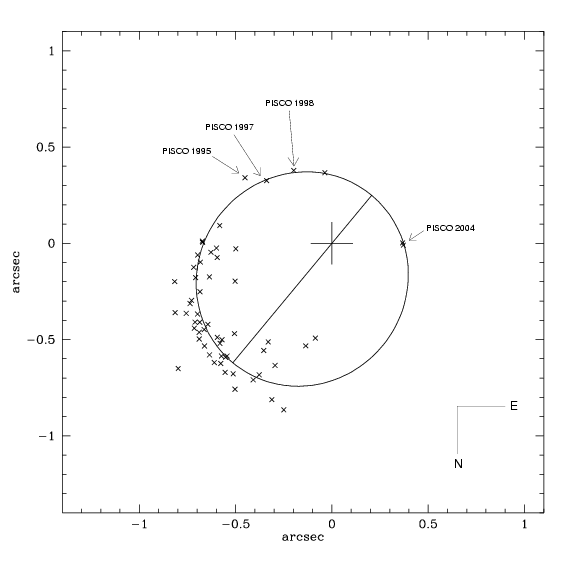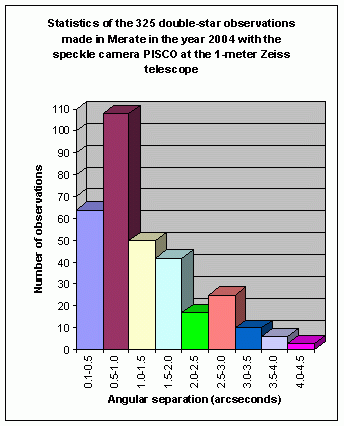SPECKLE INTERFEROMETRY OF VISUAL BINARY STARS IN MERATE
First observations in 2004
The speckle interferometry of visual binary stars began in Merate
(Osservatorio Astronomico di
Brera, Italy) at
the end of the year 2003 with the installation at the Cassegrain focus
of the 1-meter Zeiss telescope of the speckle camera PISCO (acronym for
"Pupil Interferometry Speckle Camera and COronograph), from
Midi-Pyrénées Observatory, with the Intensified CCD
detector of Nice University. Since then, systematic observations
of
close visual
binary stars with such a device, in the context of an extensive
European collaboration including astronomers from Belgium, Bulgaria,
England, France, Italy and Poland were performed. In the year 2004, in
spite of some weeks lost because of technical problems and for painting
the external side of the dome, more than binary stars were observed,
mainly by Marco Scardia. This lead to 325 measurements of the angular
separation of the components and the position angle in the sky of
the secondary star.
Orbit monitoring
The data collected in Merate allows the revision of numerous orbits.
As an example, the apparent orbit of the double star BU 1077 --
ADS 8035 is plotted here. Such orbit is mainly based on
the observations made with PISCO at Pic du Midi and Merate.
Fig. 1: Apparent orbit of the double star BU 1077 -- ADS 8035.
Precise measures of the position of binary stars
Our observations have shown that the unit
1-meter Zeiss reflector + PISCO allows to observe close binaries down
to a minimum separation of 0"14,
with a magnitude difference
between the components up to 4, and a limiting V magnitude of 10. The
accuracy is about 0"01 in
angular separation and 0.5° in position angle.
The histogram in Fig. 2 shows the distribution
versus the class of angular separation of first mesurements made in 2004.
The most recent histogram in Fig. 3 shows the
distribution of the nearly 3000 measurements obtained in Merate between
2004 and 2011.
Fig. 2. Statistics of the 325 double star
observations made in Merate in 2004 with PISCO at the 1 meter Zeiss
telescope.
Fig. 3. Statistics of all the binary
observations made in Merate from 2004 to 2011.
Fig. 4. A grating mask is placed on the top of the
Zeiss Telescope to calibrate the PISCO scale (photograph made in November 2005).
Jean-Louis Prieur (Midi-Pyrénées Observatory)
implemented the image acquisition and reduction software. The current version
of his programmes allows real-time processing of the observations. Most of
the observations collected in Merate have been published
and contributed to a large set of nice papers
(see list of PISCO publications).
All the published measurements can be found in the
Fourth Catalog of Interferometric Measurements of Binary Stars
which is the WDS data base of speckle measurements maintained by
William I. Hartkopf, Brian D. Mason (U.S. Naval Observatory, Washington DC),
and Harold. A. McAlister (CHARA, Georgia State University, Atlanta).




